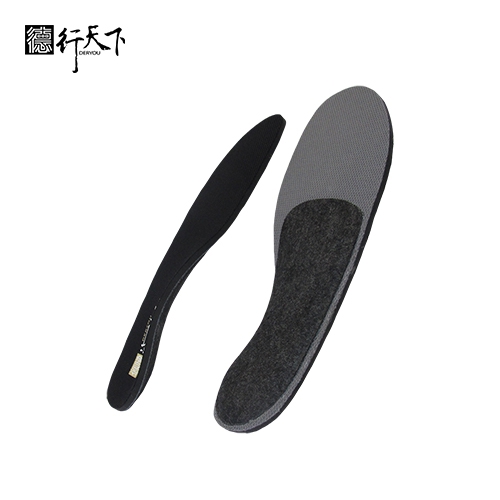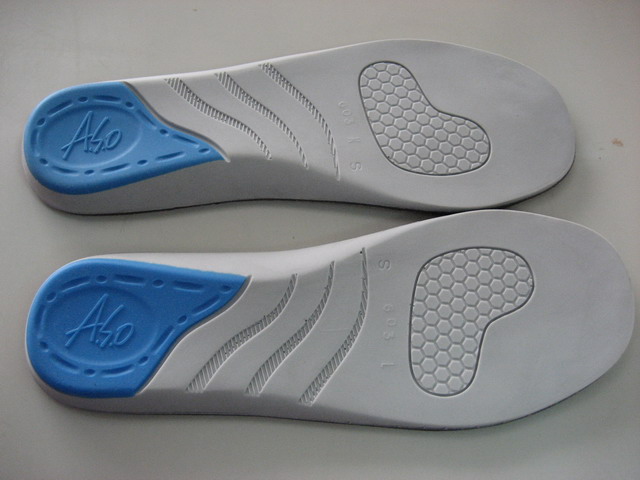Introduction – Company Background
GuangXin Industrial Co., Ltd. is a specialized manufacturer dedicated to the development and production of high-quality insoles.
With a strong foundation in material science and footwear ergonomics, we serve as a trusted partner for global brands seeking reliable insole solutions that combine comfort, functionality, and design.
With years of experience in insole production and OEM/ODM services, GuangXin has successfully supported a wide range of clients across various industries—including sportswear, health & wellness, orthopedic care, and daily footwear.
From initial prototyping to mass production, we provide comprehensive support tailored to each client’s market and application needs.
At GuangXin, we are committed to quality, innovation, and sustainable development. Every insole we produce reflects our dedication to precision craftsmanship, forward-thinking design, and ESG-driven practices.
By integrating eco-friendly materials, clean production processes, and responsible sourcing, we help our partners meet both market demand and environmental goals.


Core Strengths in Insole Manufacturing
At GuangXin Industrial, our core strength lies in our deep expertise and versatility in insole and pillow manufacturing. We specialize in working with a wide range of materials, including PU (polyurethane), natural latex, and advanced graphene composites, to develop insoles and pillows that meet diverse performance, comfort, and health-support needs.
Whether it's cushioning, support, breathability, or antibacterial function, we tailor material selection to the exact requirements of each project-whether for foot wellness or ergonomic sleep products.
We provide end-to-end manufacturing capabilities under one roof—covering every stage from material sourcing and foaming, to precision molding, lamination, cutting, sewing, and strict quality control. This full-process control not only ensures product consistency and durability, but also allows for faster lead times and better customization flexibility.
With our flexible production capacity, we accommodate both small batch custom orders and high-volume mass production with equal efficiency. Whether you're a startup launching your first insole or pillow line, or a global brand scaling up to meet market demand, GuangXin is equipped to deliver reliable OEM/ODM solutions that grow with your business.



Customization & OEM/ODM Flexibility
GuangXin offers exceptional flexibility in customization and OEM/ODM services, empowering our partners to create insole products that truly align with their brand identity and target market. We develop insoles tailored to specific foot shapes, end-user needs, and regional market preferences, ensuring optimal fit and functionality.
Our team supports comprehensive branding solutions, including logo printing, custom packaging, and product integration support for marketing campaigns. Whether you're launching a new product line or upgrading an existing one, we help your vision come to life with attention to detail and consistent brand presentation.
With fast prototyping services and efficient lead times, GuangXin helps reduce your time-to-market and respond quickly to evolving trends or seasonal demands. From concept to final production, we offer agile support that keeps you ahead of the competition.
Quality Assurance & Certifications
Quality is at the heart of everything we do. GuangXin implements a rigorous quality control system at every stage of production—ensuring that each insole meets the highest standards of consistency, comfort, and durability.
We provide a variety of in-house and third-party testing options, including antibacterial performance, odor control, durability testing, and eco-safety verification, to meet the specific needs of our clients and markets.
Our products are fully compliant with international safety and environmental standards, such as REACH, RoHS, and other applicable export regulations. This ensures seamless entry into global markets while supporting your ESG and product safety commitments.
ESG-Oriented Sustainable Production
At GuangXin Industrial, we are committed to integrating ESG (Environmental, Social, and Governance) values into every step of our manufacturing process. We actively pursue eco-conscious practices by utilizing eco-friendly materials and adopting low-carbon production methods to reduce environmental impact.
To support circular economy goals, we offer recycled and upcycled material options, including innovative applications such as recycled glass and repurposed LCD panel glass. These materials are processed using advanced techniques to retain performance while reducing waste—contributing to a more sustainable supply chain.
We also work closely with our partners to support their ESG compliance and sustainability reporting needs, providing documentation, traceability, and material data upon request. Whether you're aiming to meet corporate sustainability targets or align with global green regulations, GuangXin is your trusted manufacturing ally in building a better, greener future.
Let’s Build Your Next Insole Success Together
Looking for a reliable insole manufacturing partner that understands customization, quality, and flexibility? GuangXin Industrial Co., Ltd. specializes in high-performance insole production, offering tailored solutions for brands across the globe. Whether you're launching a new insole collection or expanding your existing product line, we provide OEM/ODM services built around your unique design and performance goals.
From small-batch custom orders to full-scale mass production, our flexible insole manufacturing capabilities adapt to your business needs. With expertise in PU, latex, and graphene insole materials, we turn ideas into functional, comfortable, and market-ready insoles that deliver value.
Contact us today to discuss your next insole project. Let GuangXin help you create custom insoles that stand out, perform better, and reflect your brand’s commitment to comfort, quality, and sustainability.
🔗 Learn more or get in touch:
🌐 Website: https://www.deryou-tw.com/
📧 Email: shela.a9119@msa.hinet.net
📘 Facebook: facebook.com/deryou.tw
📷 Instagram: instagram.com/deryou.tw
Innovative pillow ODM solution in Indonesia
Are you looking for a trusted and experienced manufacturing partner that can bring your comfort-focused product ideas to life? GuangXin Industrial Co., Ltd. is your ideal OEM/ODM supplier, specializing in insole production, pillow manufacturing, and advanced graphene product design.
With decades of experience in insole OEM/ODM, we provide full-service manufacturing—from PU and latex to cutting-edge graphene-infused insoles—customized to meet your performance, support, and breathability requirements. Our production process is vertically integrated, covering everything from material sourcing and foaming to molding, cutting, and strict quality control.Customized sports insole ODM Vietnam
Beyond insoles, GuangXin also offers pillow OEM/ODM services with a focus on ergonomic comfort and functional innovation. Whether you need memory foam, latex, or smart material integration for neck and sleep support, we deliver tailor-made solutions that reflect your brand’s values.
We are especially proud to lead the way in ESG-driven insole development. Through the use of recycled materials—such as repurposed LCD glass—and low-carbon production processes, we help our partners meet sustainability goals without compromising product quality. Our ESG insole solutions are designed not only for comfort but also for compliance with global environmental standards.Taiwan graphene sports insole ODM
At GuangXin, we don’t just manufacture products—we create long-term value for your brand. Whether you're developing your first product line or scaling up globally, our flexible production capabilities and collaborative approach will help you go further, faster.Taiwan orthopedic insole OEM manufacturing site
📩 Contact us today to learn how our insole OEM, pillow ODM, and graphene product design services can elevate your product offering—while aligning with the sustainability expectations of modern consumers.Innovative insole ODM solutions factory in Taiwan
A human interactome to prioritize drug discovery. Credit: Karen Arnott/EMBL-EBI Scientists built a protein interactome revealing shared biological processes across diseases, offering insights for drug discovery and repurposing. Scientists at Open Targets, the European Molecular Biology Laboratory’s European Bioinformatics Institute (EMBL-EBI), and GSK are revealing the shared basis of diseases using a map of interacting human proteins. By helping to understand how biological processes affect human traits and diseases, this work will prioritize new targets for drug discovery and identify drug repurposing opportunities. Proteins are molecules that do most of the work in our cells and are made following blueprints encoded in genes. They are essential for the structure, function, and regulation of the body’s tissues, and are often the target of drugs or therapies. Genome Wide Association Studies (GWAS) help us establish the genetic basis of disease by linking specific genes to diseases. To determine how those genes contribute to disease, we need to understand the function of the proteins they encode and link specific biological processes to diseases. In this new study, which will be published today (February 23, 2023) in the journal Nature Genetics, researchers created a network of interacting proteins – or an interactome – combining evidence from different sources, including EMBL-EBI’s IntAct database, Reactome, and Signor. Using this interactome, they identified groups of proteins interacting with genes that have been linked through GWAS to over 1,000 human traits from 21 therapeutic areas. Guilt-by-Association Proteins that interact with each other will likely be involved in the same biological processes. Therefore, if a protein is known to be involved in a disease, knowing which partners it interacts with provides information about the function it has in a cell. Through ‘guilt-by-association’, the interacting proteins can also sometimes be excellent therapeutic targets. The researchers found 73 clusters of proteins that were linked to more than one trait or disease, a phenomenon known as pleiotropy. Understanding these pleiotropic relationships is invaluable to drug discovery because they indicate opportunities where a therapy for one disease might be effective in another. They can also suggest drug targets to avoid, when targeting them may cause unwanted side effects. “The interactome identified some known associations, such as cardiovascular diseases and lipoprotein or cholesterol measurements,” said Inigo Barrio Hernandez, postdoctoral fellow at Open Targets and EMBL-EBI. “But we also found some unexpected associations. For example, the interactome highlighted three protein clusters shared by ten respiratory and skin immune-related diseases. This is hugely exciting because we now have some biological support to repurpose existing drugs that are proven to be safe to treat related diseases.” Finding the Cause of Diseases The network expansion is also a useful tool to assess the relative importance of genes at genomic loci identified through GWAS. GWAS compare points of common variation in the human genome between individuals with a specific trait or disease and control individuals. To identify the likely causative genes and proteins linked to the trait in question, prediction methods such as Open Targets’s Locus-to-Gene machine learning score have been developed. This method uses factors such as the distance from the point of common variation to the gene and the structure of the DNA in that location to prioritize the most relevant genes. In the present study, the researchers showed that the interactome could be used to find the proteins most likely to be involved in causing disease, using Inflammatory Bowel Disease (IBD) as an example. IBD is a complex disease with a genetic basis, but for which the disease biology is not well understood. In collaboration with Open Targets researchers who specialise in IBD, Barrio Hernandez demonstrated that the interactome could be used to prioritize a list of proteins most likely involved in the disease, based on their proximity to other IBD-linked proteins in the interactome. “This work bridges many fields of biology, including statistical genetics, cell biology, and bioinformatics,” said Pedro Beltrao, Associate Professor at ETH Zurich and former Group Leader at EMBL-EBI. “It brought together groups from across Open Targets and EMBL-EBI, and highlights the value of collaborations across disciplines.” “This is an exciting showcase of one of our Open Targets collaborative informatics projects that has generated an array of new insights for novel target discovery as well as drug repurposing, and informs our understanding of the connection between rare and common diseases through shared biological processes,” said Ellen McDonagh, Director of Informatics Science at Open Targets. “This is now being developed further to provide tissue and cell-type specific networks to help further prioritize targets for disease treatment.” Reference: “Network expansion of genetic associations defines a pleiotropy map of human cell biology” by Inigo Barrio-Hernandez, Jeremy Schwartzentruber, Anjali Shrivastava, Noemi del-Toro, Asier Gonzalez, Qian Zhang, Edward Mountjoy, Daniel Suveges, David Ochoa, Maya Ghoussaini, Glyn Bradley, Henning Hermjakob, Sandra Orchard, Ian Dunham, Carl A. Anderson, Pablo Porras and Pedro Beltrao, 23 February 2023, Nature Genetics. DOI: 10.1038/s41588-023-01327-9
Scientists have identified crucial sites on the protein CK1δ that regulate our circadian rhythm, potentially offering new ways to treat sleep, metabolic, and other health disorders. A team of scientists from Singapore and the United States discovered how a protein that regulates our biological clock can alter its own function, potentially leading to new treatments for jet lag and seasonal adjustments. Researchers from Duke-NUS Medical School and the University of California, Santa Cruz, have uncovered the key to regulating our internal biological clock. They found that this regulator is located at the tail end of Casein Kinase 1 delta (CK1δ), a protein that serves as a pacemaker for our circadian rhythm—the natural 24-hour cycles that govern sleep-wake patterns and various daily functions. Published in the journal PNAS, their findings could pave the way for new approaches to treating disorders related to our body clock. CK1δ regulates circadian rhythms by tagging other proteins involved in our biological clock to fine-tune the timing of these rhythms. In addition to modifying other proteins, CK1δ itself can be tagged, thereby altering its own ability to regulate the proteins involved in running the body’s internal clock. Previous research identified two distinct versions of CK1δ, known as isoforms δ1 and δ2, which vary by just 16 building blocks or amino acids right at the end of the protein in a part called the C-terminal tail. Yet these small differences significantly impact CK1δ’s function. While it was known that when these proteins are tagged, their ability to regulate the body clock decreases, no one knew exactly how this happened. Unraveling the Mechanism Behind CK1δ Tagging Using advanced spectroscopy and spectrometry techniques to zoom in on the tails, the researchers found that how the proteins are tagged is determined by their distinct tail sequences. Howard Hughes Medical Institute Investigator Professor Carrie Partch from the Department of Chemistry & Biochemistry at the University of California, Santa Cruz and corresponding author of the study explained: “Our findings pinpoint to three specific sites on CK1δ’s tail where phosphate groups can attach, and these sites are crucial for controlling the protein’s activity. When these spots get tagged with a phosphate group, CK1δ becomes less active, which means it doesn’t influence our circadian rhythms as effectively. Using high-resolution analysis, we were able to pinpoint the exact sites involved—and that’s really exciting.” A peptide (shown in mesh) with attached phosphate tags (red and orange spheres) blocks the active site of CK1δ. Tagging the tail end of CK1δ, a process known as auto-phosphorylation, makes the protein less active, and with that less able to fine-tune the body’s internal clocks. Credit: Jon Philpott, Rajesh Narasimamurthy and David Virshup Having first studied this protein more than 30 years ago while investigating its role in cell division, Professor David Virshup, the director of the Cancer and Stem Cell Biology Programme at Duke-NUS and co-corresponding author of the study, elaborated: “With the technology we have available now, we were finally able to get to the bottom of a question that has gone unanswered for more than 25 years. We found that the δ1 tail interacts more extensively with the main part of the protein, leading to greater self-inhibition compared to δ2. This means that δ1 is more tightly regulated by its tail than δ2. When these sites are mutated or removed, δ1 becomes more active, which leads to changes in circadian rhythms. In contrast, δ2 does not have the same regulatory effect from its tail region.” This discovery highlights how a small part of CK1δ can greatly influence its overall activity. This self-regulation is vital for keeping CK1δ activity balanced, which, in turn, helps regulate our circadian rhythms. Broader Implications of the Research The study also addressed the wider implications of these findings. CK1δ plays a role in several important processes beyond circadian rhythms, including cell division, cancer development, and certain neurodegenerative diseases. By better understanding how CK1δ’s activity is regulated, scientists could open new avenues for treating not just circadian rhythm disorders but also a range of conditions. Professor Patrick Tan, Senior Vice-Dean for Research at Duke-NUS, commented: “Regulating our internal clock goes beyond curing jet lag—it’s about improving sleep quality, metabolism, and overall health. This important discovery could potentially open new doors for treatments that could transform how we manage these essential aspects of our daily lives.” The researchers plan to further investigate how real-world factors, such as diet and environmental changes, affect the tagging sites on CK1δ. This could provide insights into how these factors affect circadian rhythms and might lead to practical solutions for managing disruptions. Reference: “Isoform-specific C-terminal phosphorylation drives autoinhibition of Casein kinase 1” by Rachel L. Harold, Nikhil K. Tulsian, Rajesh Narasimamurthy, Noelle Yaitanes, Maria G. Ayala Hernandez, Hsiau-Wei Lee, Priya Crosby, Sarvind M. Tripathi, David M. Virshup and Carrie L. Partch, 2 October 2024, Proceedings of the National Academy of Sciences. DOI: 10.1073/pnas.2415567121
Some immune systems remain youthful by maintaining a balance between innate and adaptive immune cells, a process influenced by a small subset of blood stem cells. Research suggests that controlling these stem cells’ tendency to overproduce innate immune cells could help delay immune aging and related diseases. USC researchers found that a subset of blood stem cells influences immune aging by regulating the balance between innate and adaptive immune cells. When these cells overproduce innate immune cells, the immune system ages, increasing disease risk. What helps certain immune systems stay youthful and effective in combating age-related diseases? In a recent study published in Cellular & Molecular Immunology, USC Stem Cell scientist Rong Lu and her collaborators point the finger at a small subset of blood stem cells, which make an outsized contribution to maintaining either a youthful balance or an age-related imbalance of the two main types of immune cells: innate and adaptive. Innate immune cells serve as the body’s first line of defense, mobilizing a quick and general attack against invading germs. For germs that evade the body’s innate immune defenses, the second line of attack consists of adaptive immune cells, such as B cells and T cells that rely on their memory of past infections to craft a specific and targeted response. A healthy balance between innate and adaptive immune cells is the hallmark of a youthful immune system—and a key to longevity. Findings on Blood Stem Cells and Immune Aging “Our study provides compelling evidence that when a small subset of blood stem cells overproduces innate immune cells, this drives the aging of the immune system, contributes to disease, and ultimately shortens the lifespan,” said Lu, who is an associate professor of stem cell biology and regenerative medicine, biomedical engineering, medicine, and gerontology at USC, and a Leukemia & Lymphoma Society Scholar. Lu is also a member of the Eli and Edythe Broad Center for Regenerative Medicine and Stem Cell Research at USC, and the USC Norris Comprehensive Cancer Center at the Keck School of Medicine of USC. “Our findings suggest that restraining the small subset of blood stem cells that are overproducing innate immune cells could be an effective way to delay immune aging.” Adaptive immune cells, such as B cells (pictured), are a key component of a youthful immune system. Credit: Image courtesy of the National Institutes of Allergy and Infectious Diseases In the study, first author Anna Nogalska and her colleagues found striking differences in how quickly the immune system ages—even among lab mice with the same genetic background raised in identical conditions. By the advanced age of 30 months, delayed aging mice retained a youthful balance of innate and adaptive immune cells. However, early-aging mice showed a big increase in innate immune cells relative to adaptive immune cells. By tracking the individual blood stem cells responsible for producing both innate and adaptive immune cells, the scientists discovered the subset of blood stem cells primarily responsible for the age-associated imbalance of the immune system. Specifically, the scientists observed that thirty to forty percent of blood stem cells dramatically changed their preference for producing innate versus adaptive immune cells as the mice aged. Gene Activity in Delayed and Early Agers In delayed agers, the subset of blood stem cells decreased their production of innate immune cells, protecting against the effects of aging. Among delayed agers, there was an increase in gene activity related to blood stem cells’ regulation and response to external signals—which might keep their production of innate immune cells in check. When the scientists used CRISPR to edit out these genes, blood stem cells reversed their natural tendency and produced more innate immune cells instead of adaptive immune cells—like in the early agers. In contrast, in early agers, the subset of blood stem cells shifted towards producing more innate immune cells, which, in excess, lead to many diseases of aging. Accordingly, in these early agers, the scientists found an increase in gene activity related to the proliferation of blood stem cells and the differentiation of innate immune cells. When the scientists used CRISPR to edit out these early aging genes, blood stem cells produced more adaptive immune cells instead of innate immune cells—becoming more similar to those in the delayed agers. Importantly, delayed agers tended to live longer than early agers. “In the elderly human population, the immune system often tips into producing an overabundance of innate immune cells, which can contribute to diseases such as myeloid leukemia and immune deficiencies,” said Nogalska, senior scientist and lab manager in the Lu Lab. “Our study suggests how we might promote a more youthful immune system to combat these common diseases of aging.” Reference: “Age-associated imbalance in immune cell regeneration varies across individuals and arises from a distinct subset of stem cells” by Anna Nogalska, Jiya Eerdeng, Samir Akre, Mary Vergel-Rodriguez, Yeachan Lee, Charles Bramlett, Adnan Y. Chowdhury, Bowen Wang, Colin G. Cess, Stacey D. Finley and Rong Lu, 24 October 2024, Cellular & Molecular Immunology. DOI: 10.1038/s41423-024-01225-y Ninety percent of the project was supported by federal funding from the National Institutes of Health (grants R00-HL113104,R01HL138225, R35HL150826, and 1F31HL149278-01A1) and the National Cancer Institute (grant P30CA014089). Additional funding came from the California Institute for Regenerative Medicine (grant EDUC4-12756R) and the Leukemia & Lymphoma Society (grant LLS-1370-20).
DVDV1551RTWW78V
Indonesia high-end foam product OEM/ODM 》ready to support your next launch with full-process expertiseInnovative pillow ODM solution in Vietnam 》trusted by brand builders and product innovatorsOne-stop OEM/ODM solution provider Thailand 》the smart choice for brands seeking quality and customization
下一則: ODM service for ergonomic pillows Indonesia 》commi
- ODM service for ergonomic pillows Indonesia 》commi
- Taiwan foot care insole ODM development factory 》f
- China custom neck pillow ODM 》customized solutions
- Indonesia orthopedic insole OEM manufacturer 》help
- Graphene sheet OEM supplier Thailand 》empowering y
- Vietnam ODM expert for comfort products 》craftsman
限會員,要發表迴響,請先登入


